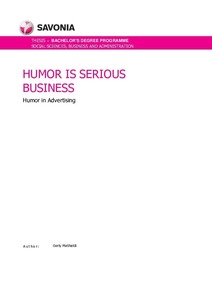Humor is Serious Business : Humor in Advertising
Matihaldi, Gerly (2018)
Matihaldi, Gerly
Savonia-ammattikorkeakoulu
2018
All rights reserved
Julkaisun pysyvä osoite on
https://urn.fi/URN:NBN:fi:amk-2018121922482
https://urn.fi/URN:NBN:fi:amk-2018121922482
Tiivistelmä
Humor in advertising is one way for companies to create attention around their brands or products. The objective of the thesis was examine the power of humorous advertisement to a consumer´s memory recall, to test differences in humor style preferences among different age groups and to examine the impact of factual contents compared to other contents in humorous video advertisements on a consumer`s purchasing behavior.
To answer the research questions, a questionnaire with 3 sections was created. Section one aimed at consumers´ memory recall of humorous advertisements, section two targeted to define the most popular humor style in advertisements among different age groups; section three studied consumer preferences of content in humorous advertisements. The questionnaire was distributed electronically through social media channels Facebook and LinkedIn. Altogether 86 respondents completed the questionnaire.
The research results showed that participants do remember humorous advertisements better than an advertisement that is non-humorous; most of the brands that were remembered were pioneering brands. A Connection with age and different humor style preferences was not found; however, there were gender differences in opinions on advertisement content and the way how advertisements were experienced by the participants. As for video advertisement, the content of the humorous advertisement does not create consumer preferences if only humorous advertisements are represented; nonetheless, gender differences occurred among participants who had international background when experiencing video advertisement. Due to the small number of participants, further research would be needed before drawing concrete conclusions.
To answer the research questions, a questionnaire with 3 sections was created. Section one aimed at consumers´ memory recall of humorous advertisements, section two targeted to define the most popular humor style in advertisements among different age groups; section three studied consumer preferences of content in humorous advertisements. The questionnaire was distributed electronically through social media channels Facebook and LinkedIn. Altogether 86 respondents completed the questionnaire.
The research results showed that participants do remember humorous advertisements better than an advertisement that is non-humorous; most of the brands that were remembered were pioneering brands. A Connection with age and different humor style preferences was not found; however, there were gender differences in opinions on advertisement content and the way how advertisements were experienced by the participants. As for video advertisement, the content of the humorous advertisement does not create consumer preferences if only humorous advertisements are represented; nonetheless, gender differences occurred among participants who had international background when experiencing video advertisement. Due to the small number of participants, further research would be needed before drawing concrete conclusions.
